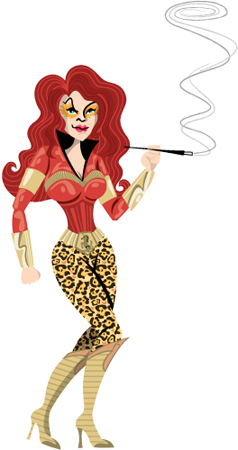The proverb goes, “If you haven’t anything nice to say, don’t say anything at all.”
Alice Roosevelt Longworth, however, said, “If you haven’t got anything nice to say about anybody, come sit next to me.”
OK, Alice. Here we go.
I’ve seen a lot of good theatre in my life, and a fair bit of terrible theatre as well. Some of this wasn’t all that surprising – mothers and partners will drag one to see Starlight Express or Sunset Boulevard or (heaven help me) Blood Brothers, and sometimes you just can’t say no. But, see, that’s stuff that you know is going to be awful – you can prepare. Down a gin & tonic or three, steel yourself for the worst and hope for some good production design. It may be awful, but it’s fairly guileless (not to say mindless), and hell, some people really seem to like it. There’s something truly horrifying, though, about seeing a great play with a lot of potential done so badly it makes you shake. People, let me tell you: the production of The Philadelphia Story currently on at the Old Vic is exactly that kind of awful. It may be the worst production of a good thing that I’ve ever, ever seen. Ever.
How do I begin to explain the atrocities we witnessed? I’ve directed The Philadelphia Story, in whole or in part, four times and can tell you unequivocally that it’s both charming and funny. Really, really funny. So effortlessly well written and funny, in fact, it’s a great way for young actors to learn comic timing. It’s easy: just listen to the other guy, say your line, and people will laugh. It can’t fail.
Except it did.
In the interest of full disclosure, I’ll admit that I did laugh a few times, but with very few exceptions, I was laughing at a line I knew and loved and not the delivery. Which probably had a lot to do with the fact that the delivery was uniformly wooden. Wooden and monotone. Wooden and monotone with really appallingly bad American accents. Wooden and monotone and – are you getting the picture yet? Good.
It does bear mentioning that the set was lovely – a traditional approach with a fine eye for detail and much attention paid to appropriate props and expert faux finishing. It’s a shame, really, that only the front three feet of it were used. A fellow victim audience member remarked that he’d begun to suspect the actors were all just being dragged back and forth on a track like those duck-shaped cutouts you throw softballs at in the carnival stall. Which, judging by their emotive prowess, seems entirely possible.
It wasn’t until about two minutes before the second interval that I realised what it was that was so dreadful about the acting: nobody on the stage was listening to anybody else on the stage. They could have been in different theatres for all the interaction and banter I saw – everyone was perpetually just waiting to say their next line. As an actor, I’m all for running lines on one’s own, but that’s normally the sort of thing that’s best confined to, oh, say the dressing room. It certainly shouldn’t be brought onto the stage, unless one is going for a more postmodern effect. Maybe that’s it – maybe they got confused and thought they were doing Waiting for Godot or No Exit and not an elegant little 1930s romantic farce.
I am told that when Kevin Spacey was a member of the cast, the production was enjoyable, if not exactly spectacular. I believe the Guardian referred to it as “decent enough”. But it seems to me that any production which suffers so grievously from the exchange of a single cast member is seriously flawed to begin with, and really I had expected much more from Mr. Spacey as a director in the way of things like… direction. You know, blocking. And tone. And pace. And… oh, never mind.
We escaped, most of us, at the second interval. I can only imagine how the third part went. By the time my drink arrived at the pub across the road I was visibly shaking, so I imagine if I’d attempted to stay I would have had a grand mal seizure if not a stroke.
So, dear readers, I urge you to learn from my misfortune: do not, under any circumstances, see this show. I leave you with a fine description of the experience, courtesy of the Third Geneva Convention (Chapter 3, Section 1):
“Collective punishment for individual acts, corporal punishment, imprisonment in premises without daylight and, in general, any form of torture or cruelty, are forbidden.”
‘Nuff said. Rent this instead.
